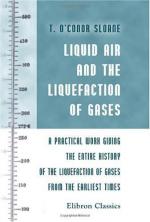|
This section contains 1,346 words (approx. 5 pages at 300 words per page) |

|
Since the 1600s, chemists have known that temperature can determine whether a substance exists as a gas, liquid, or solid. Johannes van Helmont, who coined the term gas to describe carbon dioxide, used a different term, vapors, to describe substances that became gaseous only when heated, such as water. During the late 1700s, scientists learned that when a gas is cooled, its volume is reduced by a predictable amount. Cooling slows down the motion of the gas molecules, so they take less space. Similarly, pressurizing a gas, or forcibly squeezing its molecules closer together, reduces its volume. Eventually, through cooling and compression, the volume of a gas can be reduced by so much that its molecules collapse upon each other and come into contact--in other words, the gas changes into a liquid. Compression and cooling soon became the twin tools of scientists attempting to...
|
This section contains 1,346 words (approx. 5 pages at 300 words per page) |

|


